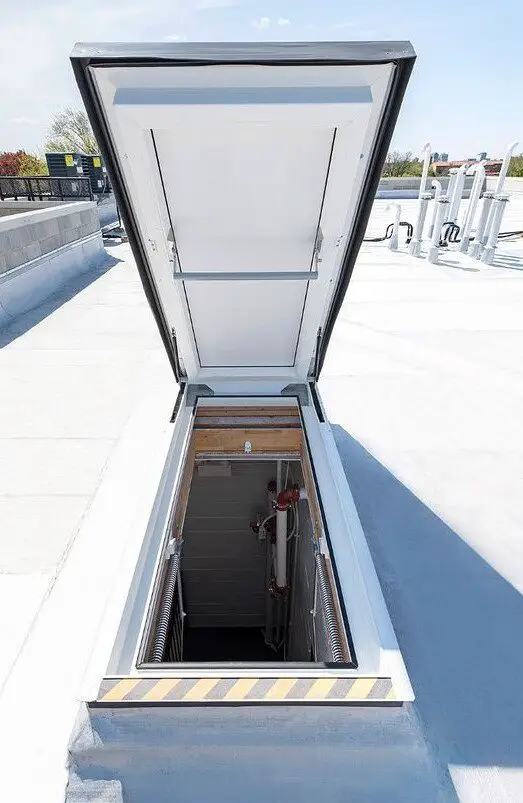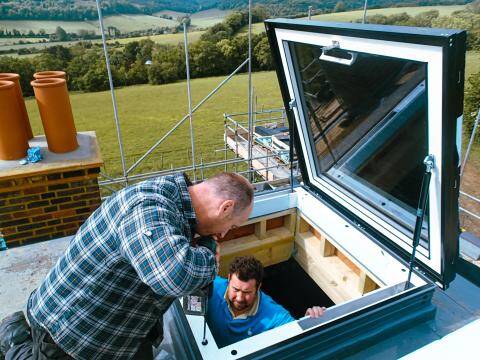When replacing or installing a new roof hatch, making the right selection is important for safety and functionality. A wide range of hatches exist for different weight ratings and use cases. This blog post lets you explore the key factors, like material, latching systems, and dimensions, to help you select the ideal roof hatch solution for your specific house or commercial establishment project’s needs.
7 Essential Factors to Check When Purchasing Roof Hatch
Picking a roof hatch that meets your structure project’s requirements and demands takes some planning. Below are seven crucial factors to check when buying the most suitable roof hatch for your home or commercial building’s access necessities.
- Size and Dimensions
Measuring the roof area size is crucial. You must make sure the hatch will fit in that space properly. Consider what needs to go through the opening, like tools, supplies, and people. You want to choose a hatch big enough that nothing gets stuck when moving it in or out of the roof.

- Materials
Manufacturers commonly make roof hatches out of three materials—aluminum, steel, and fiberglass. Aluminum-built hatches, like BA-ALRF-LA aluminum roof hatch, are light but easily dent if bumped. Steel is tough but will rust over time in some weather conditions. Fiberglass is very sturdy and can handle rain and sun without issues.
It would be best if you chose based on what climate you live in. If it rains a lot where you are, fiberglass or steel would be better since they don’t rust. Aluminum would work well in dry areas. Remember to also think about how much bumping and banging the hatch may get, as steel could take more abuse than aluminum before getting damaged.
- Door Style
Hatches come with doors of multiple panels or a single solid piece. Panel doors are lighter to open and close since they have separate sections that move. However, wind and cold air can blow through the cracks between panels.
Solid doors, on the other hand, grant better insulation since they are one solid piece that seals tightly. But they are very heavy to lift open and shut. You should also consider whether drafts will be an issue for your use and whether you can effortlessly handle the weight of a solid door, given that ensuring safety is vital. Pick the door style best suited to your work needs and ability.
- Insulation
For temperature control, seek out insulated hatch options. Insulation helps maintain a stable temperature in the roof area, allowing building occupants and employees to work throughout all seasons.
In very hot or cold places, insulation makes a big difference in keeping enclosed spaces livable year-round. It prevents outside heat or chill from easily transferring through the hatch material. Hence, you must highly consider this, especially if the condition sees major temperature swings from season to season.
- Lifting System
Hatches have presented various alternatives for helping lift the door open and closed. Common systems include gas shocks, springs, and pulley setups. Gas shocks and springs provide power to assist with lifting.
Meanwhile, pulleys make raising or lowering the door easier while keeping balance. Consider your strength and pick a lifting system you can work with safely using only one hand. That way, your other hand will be free for holding tools, supplies, or other items when going in and out of the hatch opening.
- Safety Railings
Railings play an important safety role. They help guard against accidental falls through the open hatch area. Be sure any railings surround the perimeter of the hatch opening.
It protects you while in or around the space. These railings must match the hatch size so protection extends across the access area. Also, double-check its compliance with building codes for fall safety measures to ensure security from injuries and tumbles off the roof.

- Hardware
The hinges, latching mechanisms, and other small parts on a hatch are important to guarantee the component’s proper functioning over the long run. Hatches need hardware strong enough to stand firm against heavy usage over time. Among hardware materials, stainless steel weathers environmental elements like extreme heat, cold, rain, and snow better than alternatives.
Using stainless steel avoids common issues, such as rust that can weaken other metal parts quicker than expected. So, when looking for hatches, consider the hardware’s quality, too. Adequate sturdiness guarantees the hatch continues operating seamlessly for all seasons as required for roof access.
Pick What’s Best for Your Project
Choosing the right hatch requires considering your building’s unique access needs and environment. Taking the time to measure and assess materials and systems compatibility will save costs. A hatch is an important safety investment that also enhances work efficiency. With so many options, the essential factors listed in this blog aim to help you purchase a hatch solution tailored for reliable, durable performance on your job sites for years to come.










